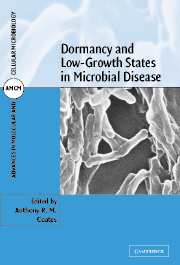Book contents
- Frontmatter
- Contents
- Contributors
- Preface
- 1 Physiological and molecular aspects of growth, non-growth, culturability and viability in bacteria
- 2 Survival of environmental and host-associated stress
- 3 Surviving the immune response: an immunologist's perspective
- 4 Quantitative and qualitative changes in bacterial activity controlled by interbacterial signalling
- 5 Mechanisms of stationary-phase mutagenesis in bacteria and their relevance to antibiotic resistance
- 6 Biofilms, dormancy and resistance
- 7 Tuberculosis
- 8 Gastritis and peptic ulceration
- 9 Resumption of yeast cell proliferation from stationary phase
- 10 Resting state in seeds of higher plants: dormancy, persistence and resilience to abiotic and biotic stresses
- Index
- Plate section
6 - Biofilms, dormancy and resistance
Published online by Cambridge University Press: 18 August 2009
- Frontmatter
- Contents
- Contributors
- Preface
- 1 Physiological and molecular aspects of growth, non-growth, culturability and viability in bacteria
- 2 Survival of environmental and host-associated stress
- 3 Surviving the immune response: an immunologist's perspective
- 4 Quantitative and qualitative changes in bacterial activity controlled by interbacterial signalling
- 5 Mechanisms of stationary-phase mutagenesis in bacteria and their relevance to antibiotic resistance
- 6 Biofilms, dormancy and resistance
- 7 Tuberculosis
- 8 Gastritis and peptic ulceration
- 9 Resumption of yeast cell proliferation from stationary phase
- 10 Resting state in seeds of higher plants: dormancy, persistence and resilience to abiotic and biotic stresses
- Index
- Plate section
Summary
INTRODUCTION
Extent of the Problem in Medicine
Biofilm growth almost always leads to a massive increase in resistance to antibiotics and biocides by orders of magnitude compared with cultures grown in suspension (planktonic) in conventional liquid media. Currently, there is no generally agreed upon mechanism to account for this broad resistance to chemical agents. We suggest that dormancy, related to the general stress response and associated survival responses, offers an explanation for the overall general resistance of biofilm microbes.
A bacterial biofilm is typically defined as a population of cells growing as a consortium on a surface and enclosed in a complex exopolymer matrix. Commonly in the wider environment but less so in infections, the population is mixed and also of heterogeneous physiologies (22). This is partly because of nutrient (including oxygen) gradients across the biofilm (92). It seems likely that biomasses not associated with a surface may also exhibit biofilm properties, because of the influence of cell density on microbial physiology (12, 37). The biofilm mode of growth contributes to resistance to host defences and, within the biofilm, at least some of the cells are phenotypically highly resistant to antibiotics and biocides (58, 60). Medical examples are numerous and include dental biofilms and also burns and urinary tract and lower respiratory infections. The carrier state for several infections involves pharyngeal colonisation. Implanted devices are a major source of biofilm infection, e.g., catheters and pacemakers, as are orthopaedic and other prostheses (4).
- Type
- Chapter
- Information
- Dormancy and Low Growth States in Microbial Disease , pp. 161 - 180Publisher: Cambridge University PressPrint publication year: 2003
- 3
- Cited by

